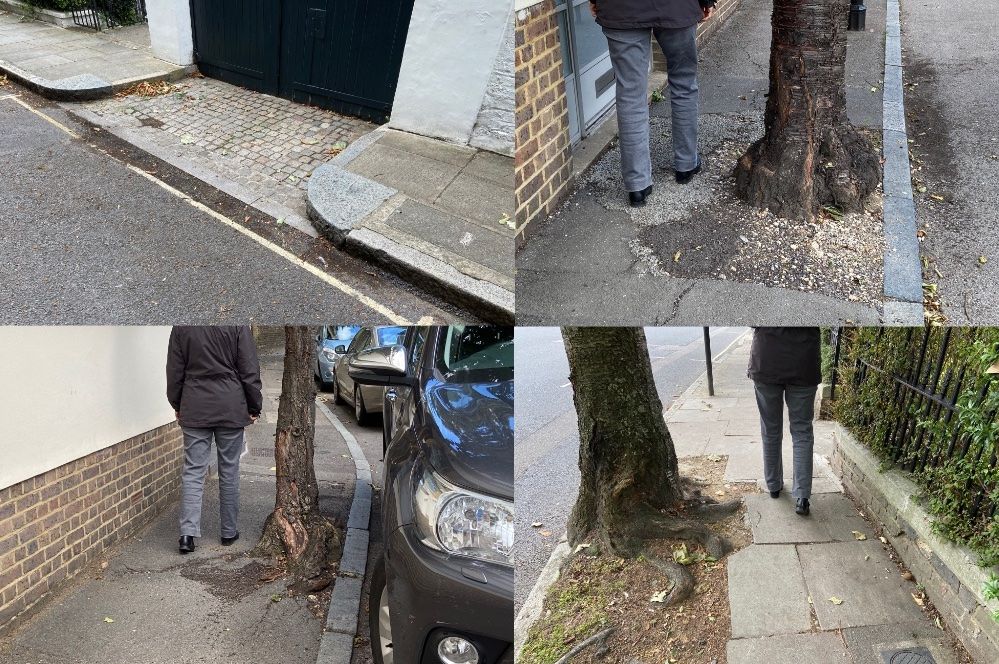Published 7 September 2020; updated 6 February 2021
Drivers often assume that all disabled people drive everywhere, but our survey shows this to be untrue – taking all disabilities into account, they are no more likely to use cars than the rest of us. For example, in our area only half of the people who use mobility scooters also use a car. And 80% of those who use both cars and mobility scoots are in favour of the Council taking action to reduce through traffic. To understand why just read the experiences of Carly and Steven, two local people who are brave enough to use mobility scooters on our streets.

People who use some form or wheelchair or mobility scooter generally find getting around within an LTN much easier than on streets with traffic. For them some pavements can effectively be impassable: some are just too narrow; tree roots can make the surface uneven and driveways may introduce kerbs. Roads would be ideal alternatives but traffic can make them too dangerous. In a LTN there is so little traffic that wheelchair and mobility scooter users feel safe on the roads and can get around easily.

And there are numerous people who just find walking difficult. Alex described the stresses of walking on heavily trafficked streets while recovering from a stroke.

People with visual impairments will benefit from reduced traffic and road danger, and the reduction in noise should help with navigating their local area more easily.
LTNs keep through traffic out of the area and discourage non-essential car users from making short journeys. In Islington's People Friendly Streets the essential car user can still reach every single address by car or taxi. No disabled person is prevented going anywhere by car.
Most LTNs go through a difficult initial period when drivers are confused by what has happened to the roads. It takes time for them to understand and to make new and better choices about their journeys. Once this period is over experience shows (see Lambeth LTN traffic figures (December 2020)) that the traffic, both inside the LTN and on the boundary roads too, settles down to be less than it was before. This means that for those who really do have to drive, the journey, while maybe a slightly greater distance, will actually be less congested.
Interestingly Devon County Council have adopted a new approach for their social care teams. Cycling Industry News reports that, of the 13 Council e-Cargo bikes in Exeter, two will be used by the local hospital's adult and social care teams to reach some of the city's most isolated people.
In countries such as the Netherlands, many cities have extensive networks of filtered roads. People there, young and old, of all abilities, use the safe and convenient bike lanes which also afford safe and direct travel for people who need to use mobility scooters.
Remember, any one of us could have our mobility challenged tomorrow. We know from personal experience that a broken leg can put you in a wheelchair for a few weeks; a sprained ankle can make walking very difficult, but cycling can be easy. As Wheels for Wellbeing says:
One of the biggest barriers to more disabled people taking up cycling is the general assumption that disabled people can't or don't cycle.
Islington will not make that mistake – the filters in our People Friendly Streets will be accessible, allowing mobility vehicles to pass through unhindered.
We also must not assume that beyond a certain age everyone has to rely on motorised transport. Exercise keeps one young and we know people well into their 80s who use cycling as their main means of transport. Truly "8 to 80" and beyond!
February 2021: Transport for All published the report Pave the Way:
At a time where many disabled people are shielding or otherwise not physically outside and accessing streetspaces, there's a real fear that disabled voices are not present in decision making. As the 'new normal' is being shaped we ask that those designing our rapidly changing streetscapes commit to making these shared spaces a world-class example of equity, community and harmony, for everyone.
This report really brought home to us how diverse are the ways in which a person can be disabled and the different ways in which they make use of their local roads. Campaigners on both sides of the LTN debate tend to focus on the disabilities that favour their argument, and to ignore the others. We will try always to look at the broader picture. Of course, it's the Council that really needs to understand the many ways in which streetscape changes can impact the disabled. We will raise this topic when we meet with councillors and keep reminding them to listen to our disabled members and neighbours themselves.
2022: Our Councillors have been listening to the feedback from the LTNs that have already been introduced. As a result they are introducing an exemption for a car used by a Blue Badge holder. Details on the Council's Blue Badge holder FAQs page.
Sources
Cycling Industry News: Local Government Association report urges business "trade vans for cargo bikes"








